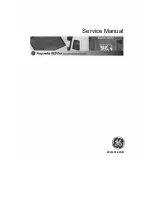
Spectrum Analyzer Menus
6–14
2715 User Manual
4. To create a new antenna entry, press [6] ANTENNA SETUP. Enter the start,
stop, and frequency steps at which measurements will be made. Enter the
reference distance.
The reference distance is the distance to which you want the field strength
referred. For maximum accuracy your antenna should be calibrated at the
reference distance and your measurement made at that distance. However, if
you require another distance, enter it here. For instance, if you are making
measurements at 10 meters, but want the field strength at 3 meters, then
enter 3 meters.
5. Press [
a
] to return to EDIT ANTENNA TABLE.
Item 0 will continue to indicate EMPTY at the end of the line because there
are still no antenna factors in the local buffer.
6. To edit an old antenna entry, press [3] LOAD from the EDIT ANTENNA
TABLE and choose the antenna you want to edit.
If there is already something in the local buffer, you are given the choice:
W = OVERWRITE LOCAL BUFFER
Z = ABORT
7. If you need the data currently in the local buffer, abort the procedure and
store it. Otherwise, press [W].
After the antenna is loaded, its name (if it has one) or number is shown at the
end of the first line of EDIT ANTENNA TABLE indicating that the antenna
factors for that antenna have been loaded into the local buffer.
If you attempt to change the frequencies at which you plan to use an antenna,
whether it is a newly created antenna or an old one, you must delete the local
buffer and start over as though it is a new antenna. To delete the local buffer,
select item 4, DELETE from EDIT ANTENNA TABLE and then select item 6,
EDITING BUFFER. Confirm the deletion by pressing [Y] and proceed as
though you are creating a new antenna table.
8. After you have loaded an old antenna table or established the frequency
range and calibration distance for a new one, press [0] from EDIT ANTEN-
NA TABLE.
A list of frequencies beginning with the start frequency and ending with the
stop frequency appears. The numbers to the right of the frequencies are the
antenna factors, or K-factors. When creating antenna tables, the 2715
supplies default values of zero for the K-factors.
9. To begin changing the antenna factors, press [W] and enter the appropriate
factor.
The asterisk indicates which factor is to be edited.
Summary of Contents for 2715
Page 4: ......
Page 12: ...Table of Contents viii 2715 User Manual ...
Page 18: ...Preface xiv 2715 User Manual ...
Page 19: ...Introduction ...
Page 20: ......
Page 24: ...Introduction 1 4 2715 User Manual ...
Page 25: ...Getting Started ...
Page 26: ......
Page 46: ...Getting Started 2 20 2715 User Manual ...
Page 47: ...Operating Basics ...
Page 48: ......
Page 70: ...Operating Basics 3 22 2715 User Manual ...
Page 71: ...Dedicated Controls ...
Page 72: ......
Page 108: ...Dedicated Controls 4 36 2715 User Manual ...
Page 109: ...CATV Measurements ...
Page 110: ......
Page 181: ...Spectrum Analyzer Menus ...
Page 182: ......
Page 274: ...Spectrum Analyzer Menus 6 92 2715 User Manual ...
Page 275: ...Appendices ...
Page 276: ......
Page 302: ...Appendix B Broadcast AM FM and TV Signal Sources B 2 2715 User Manual ...
Page 318: ...Appendix C System Messages C 16 2715 User Manual ...
Page 334: ...Appendix E External Input and Output E 12 2715 User Manual ...
Page 339: ...Glossary and Index ...
Page 340: ......
Page 359: ......
Page 360: ......
















































